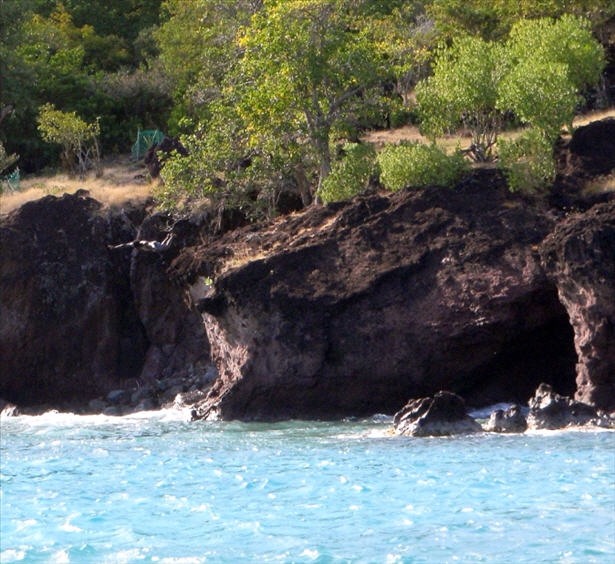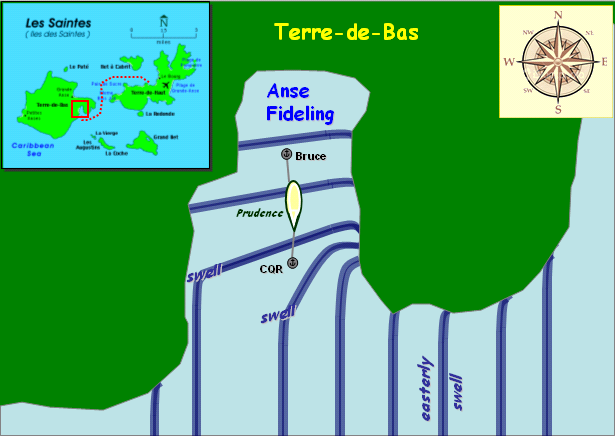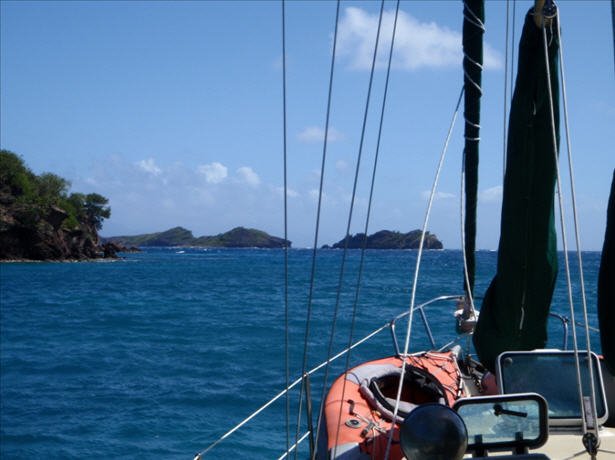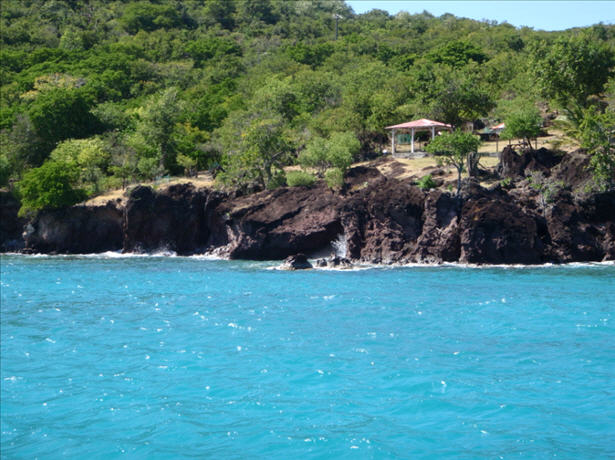

- PHOTOS:
- Dec 16, 2008 - May 21, 2009
- Mar 17, 2008 - Dec 15, 2008
- Nov 01, 2007 - Mar 16, 2008
- Our SC35 Sailboat: PRUDENCE
- SELECTED BLOGS
- Jan'05: The Idea
- May'05: First Cruise - Belize
- Aug'05: Buying Ashiya
- Oct'05: School in St. Vincent
- Nov'05: Ocracoke on Ashiya
- Jul'06: Long Trip on Ashiya
- Oct'06: Prudence Comes Home
- Nov'07: First Night Offshore
- Nov'07: Offshore Take Two
- Nov'07: Gulf Stream Crossing
- Dec'07: Green Turtle Cay
- Dec'07: Lynyard Cay
- Dec'07: Warderick Wells Cay
- Jan'08: George Town
- Jan'08: Life without a Fridge
- Jan'08: Mayaguana Island
- Jan'08: Turks & Caicos
- Jan'08: Dominican Republic
- Jan'08: Down the Waterfalls
- Feb'08: Puerto Rico
- Feb'08: Starter Troubles
- Feb'08: Vieques
- Mar'08: Finally Sailing Again
- Mar'08: Trip So Far
- Mar'08: Hiking Culebra
- Mar'08: Kayak & Snorkel I
- Mar'08: Teak and Waterspouts
- Mar'08: Kayak & Snorkel II
- Mar'08: Bottom Cleaning
- Apr'08: Culebra Social Life
- Apr'08: Culebra Routine
- Apr'08: Culebra Beaches
- Apr'08: Culebrita
- Jun'08: Kayak & Snorkel III
- Jun'08: Kayak & Snorkel IV
- Jun'08: Manta Ray
- Jun'08: Sea Turtles
- Jul'08: Cost of Cruising
- Jul'08: Busy Week in Culebra
- Jul'08: Getting to Land
- Jul'08: Leatherback Boil
- Jul'08: Fish and Volcano Dust
- Aug'08: Teaching Algebra
- Sep'08: Culebra Card Club
- Oct'08: Kayak & Snorkel V
- Oct'08: Prep for Hurricane
- Oct'08: Hurricane Omar
- Oct'08: Fish and Sea Glass
- Oct'08: Waterspouts
- Dec'08: Hurricane Season Ends
- Dec'08: Culebra to St. Martin
- Jan'09: Antigua Part 1
- Feb'09: The Saints
- Feb'09: Visiting Dominica
- Mar'09: Antigua Part 2
- Apr'09: Antigua to Bermuda
- May'09: Bermuda to Norfolk
- FULL LIST of Blog Entries
15 July 2009
14 July 2009
15 June 2009
14 June 2009 | Annapolis, MD
13 June 2009
12 June 2009
11 June 2009
10 June 2009 | Little Creek Marina, Norfolk, VA, USA
04 June 2009 | Little Creek Marina, Norfolk, VA, USA
31 May 2009 | Little Creek Marina, Norfolk, VA, USA
29 May 2009 | Little Creek Marina, Norfolk, VA, USA
26 May 2009 | Little Creek Marina, Norfolk, VA, USA
25 May 2009 | Little Creek Marina, Norfolk, VA, USA
13 May 2009 | through 21-May-2009
13 May 2009 | through 21-May-2009
12 May 2009 | St George's Town, Bermuda
11 May 2009 | St George's Town, Bermuda
07 May 2009 | St George's Town, Bermuda
04 May 2009 | St George's Town, Bermuda
21 April 2009 | through 02-May-2009
Escape from Rolly Conditions
24 February 2009 | Anse Fideling, Terre de Bas, The Saints, Guadeloupe

CURRENT LOCATION: Anchored in Anse Fideling off the island of Terre de Bas in the Iles Des Saintes, Guadeloupe
15 51.235' N, 061 37.252' W
After Sheryl finished checking us in on Monday morning, we finally cried 'uncle' and decided to make a move in an attempt to escape the swell. By the time we finished up a little bit of internet business, we were rolling such that the toerails were nearly touching the water. The hard drive on my laptop kept stopping as we took big swings from one side to the other. It was time to go.
As we were making our preparations, a catamaran in front of us (just off to our port side) picked up their anchor. Sheryl noticed that they were spending a lot of time hovering in front of our boat. As they swung side-to-side, we could see between the two hulls. They had caught something with their anchor. We could not tell what it was, but suspected that it might be a fish cage. It seemed to take them forever to free themselves, and I kept hoping that they would not drop the debris on top of our rode.
Once they finally cleared the area, we hurried along in our own preparations for departure before someone else would block our escape. With 300 pounds of ground tackle lying 35-feet below our boat, it was going to take me a while to pull it up. In addition, with winds pushing 20-knots, we would need lots of room around us to be certain that we did not pick up anyone else's rode in the process.
Lifting our ground tackle from depths like these is both slow and exhausting. We have a manual windlass, and I employed it partway, but even moving the lever as fast as possible, it takes 5 minutes just to bring in 20 feet of chain. We had 160 feet in the water. So, I used a combination of windlass arm and raw back strength, alternating to give the different muscle groups a break. Sheryl was at the helm and guided the boat forward in order to take the lateral strain off of the chain (and ultimately off of me).
Those last 40-feet were the worst. This is the point where the anchor has been broken free of its holding and I am facing a dead lift of 120 lbs, pulling straight up. Meanwhile, Sheryl has to try to keep the boat from drifting into anything or anyone, while yet not putting on too much headway and creating drag on the anchor moving forward through the water (thus increasing the difficulty of my task). We were both exhausted and a bit edgy by the time the CQR was back on the bow roller. We are just not well equipped for deep-water anchor retrieval here on Prudence.
Our destination anchorage, Anse Fideling, is on the south side of the island to our west. The total distance was less than 4 nautical miles and we were too spent to even raise sail. One big advantage of this anchorage is the depth of the water. We should be able to anchor in 15-feet or less (thus avoiding a replay of today's excruciating exercise). The disadvantage of the anchorage, though, is two-fold:
First, the anchorage is protected on three sides by some fairly high and steep hills. In our experience, this blocks the normal windflow and creates a situation where the winds quickly range from calm to gusty and can push you around at anchor in any variety of directions. When we motored into the anchorage and circled the area with the depths we desired, we found this to be the case. Try as she might, Sheryl could not find a consistent wind direction to point the boat for laying out the anchor. Fortunately, save for some small local boats moored in the shallower waters near the beach, the anchorage was all ours. We took our time selecting a spot in which to set our CQR.
The second disadvantage is the lack of total protection from the swell. Anse Fideling is south facing and reasonably deeply cut into the island; however, ocean swell is insidious. It tends to wrap around a land mass and keep on marching toward the shoreline. Forecasts for 8-10 foot easterly swells over the next two days gave me the incentive to make a little extra effort in the anchoring process. Today, we would try a stern anchor.
We have anchored bow and stern only once before, when we used the combo to stay out of the ICW channel near Beaufort, NC. On that occasion, we used the Fortress as our stern anchor. Since the Fortress is currently stowed in the cockpit locker and our next journey will find us immediately out in open water, I decided to try something different. We would drop the Bruce anchor off the bow and lead it back to the stern.
While I changed into my swim trunks and donned my snorkel gear, Sheryl removed the retaining pin from the Bruce and attached a fender to the crown with a bowline knot. She lowered the Bruce, fender and chain down to me in the water and I began to swim toward the shoreline. Sheryl fed our braided rope rode over the bow until I got a suitable distance away, then led an extra boat length of rode back to the cockpit winch.
I had intended to untie the bowline and let the Bruce fall where I wanted it, but could not get the weight off the line to undo the knot. Rather than swim the entire construct back to the boat, I left it floating and went to get a dive knife. Next time we use a fender to facilitate the swim of an anchor, we will know to tie a slip knot. Once I cut it free, the Bruce dropped right into the sandy spot I had destined for it.
Sheryl took a couple of wraps around the winch and cranked in the rode. Slowly she turned the boat about 90 degrees, so that the bow was pointing out the mouth of the bay. In this orientation, we should ride the bulk of the swell working its way into Anse Fideling in a comfortable manner.

Our efforts were soon justified, as we watched two other boats join us at anchor that afternoon. Both swung around at the mercy of the wind, and when they were beam-to the swell (which was most of the time) it could not have been comfortable aboard. Meanwhile we enjoyed a gentle boat motion, and I was able to sleep in the v-berth for the first time in two days.
Anse Fideling is a beautiful anchorage, with views of some small barrier islands to our south ...

... and small cliffs off our stern:

If you take a close look at the lead photo, you can see one of the local youths diving off those cliffs. This was our early evening entertainment. Twenty years ago, I would have been itching to take the same leap myself. Unfortunately, age has brought along with it a healthy dose of fear designed to protect my much more brittle body. I suppose it is for the best. It would be totally incongruous for one of the crew of a boat named "Prudence" to become incapacitated in a cliff-diving accident.

15 51.235' N, 061 37.252' W
After Sheryl finished checking us in on Monday morning, we finally cried 'uncle' and decided to make a move in an attempt to escape the swell. By the time we finished up a little bit of internet business, we were rolling such that the toerails were nearly touching the water. The hard drive on my laptop kept stopping as we took big swings from one side to the other. It was time to go.
As we were making our preparations, a catamaran in front of us (just off to our port side) picked up their anchor. Sheryl noticed that they were spending a lot of time hovering in front of our boat. As they swung side-to-side, we could see between the two hulls. They had caught something with their anchor. We could not tell what it was, but suspected that it might be a fish cage. It seemed to take them forever to free themselves, and I kept hoping that they would not drop the debris on top of our rode.
Once they finally cleared the area, we hurried along in our own preparations for departure before someone else would block our escape. With 300 pounds of ground tackle lying 35-feet below our boat, it was going to take me a while to pull it up. In addition, with winds pushing 20-knots, we would need lots of room around us to be certain that we did not pick up anyone else's rode in the process.
Lifting our ground tackle from depths like these is both slow and exhausting. We have a manual windlass, and I employed it partway, but even moving the lever as fast as possible, it takes 5 minutes just to bring in 20 feet of chain. We had 160 feet in the water. So, I used a combination of windlass arm and raw back strength, alternating to give the different muscle groups a break. Sheryl was at the helm and guided the boat forward in order to take the lateral strain off of the chain (and ultimately off of me).
Those last 40-feet were the worst. This is the point where the anchor has been broken free of its holding and I am facing a dead lift of 120 lbs, pulling straight up. Meanwhile, Sheryl has to try to keep the boat from drifting into anything or anyone, while yet not putting on too much headway and creating drag on the anchor moving forward through the water (thus increasing the difficulty of my task). We were both exhausted and a bit edgy by the time the CQR was back on the bow roller. We are just not well equipped for deep-water anchor retrieval here on Prudence.
Our destination anchorage, Anse Fideling, is on the south side of the island to our west. The total distance was less than 4 nautical miles and we were too spent to even raise sail. One big advantage of this anchorage is the depth of the water. We should be able to anchor in 15-feet or less (thus avoiding a replay of today's excruciating exercise). The disadvantage of the anchorage, though, is two-fold:
First, the anchorage is protected on three sides by some fairly high and steep hills. In our experience, this blocks the normal windflow and creates a situation where the winds quickly range from calm to gusty and can push you around at anchor in any variety of directions. When we motored into the anchorage and circled the area with the depths we desired, we found this to be the case. Try as she might, Sheryl could not find a consistent wind direction to point the boat for laying out the anchor. Fortunately, save for some small local boats moored in the shallower waters near the beach, the anchorage was all ours. We took our time selecting a spot in which to set our CQR.
The second disadvantage is the lack of total protection from the swell. Anse Fideling is south facing and reasonably deeply cut into the island; however, ocean swell is insidious. It tends to wrap around a land mass and keep on marching toward the shoreline. Forecasts for 8-10 foot easterly swells over the next two days gave me the incentive to make a little extra effort in the anchoring process. Today, we would try a stern anchor.
We have anchored bow and stern only once before, when we used the combo to stay out of the ICW channel near Beaufort, NC. On that occasion, we used the Fortress as our stern anchor. Since the Fortress is currently stowed in the cockpit locker and our next journey will find us immediately out in open water, I decided to try something different. We would drop the Bruce anchor off the bow and lead it back to the stern.
While I changed into my swim trunks and donned my snorkel gear, Sheryl removed the retaining pin from the Bruce and attached a fender to the crown with a bowline knot. She lowered the Bruce, fender and chain down to me in the water and I began to swim toward the shoreline. Sheryl fed our braided rope rode over the bow until I got a suitable distance away, then led an extra boat length of rode back to the cockpit winch.
I had intended to untie the bowline and let the Bruce fall where I wanted it, but could not get the weight off the line to undo the knot. Rather than swim the entire construct back to the boat, I left it floating and went to get a dive knife. Next time we use a fender to facilitate the swim of an anchor, we will know to tie a slip knot. Once I cut it free, the Bruce dropped right into the sandy spot I had destined for it.
Sheryl took a couple of wraps around the winch and cranked in the rode. Slowly she turned the boat about 90 degrees, so that the bow was pointing out the mouth of the bay. In this orientation, we should ride the bulk of the swell working its way into Anse Fideling in a comfortable manner.

Our efforts were soon justified, as we watched two other boats join us at anchor that afternoon. Both swung around at the mercy of the wind, and when they were beam-to the swell (which was most of the time) it could not have been comfortable aboard. Meanwhile we enjoyed a gentle boat motion, and I was able to sleep in the v-berth for the first time in two days.
Anse Fideling is a beautiful anchorage, with views of some small barrier islands to our south ...

... and small cliffs off our stern:

If you take a close look at the lead photo, you can see one of the local youths diving off those cliffs. This was our early evening entertainment. Twenty years ago, I would have been itching to take the same leap myself. Unfortunately, age has brought along with it a healthy dose of fear designed to protect my much more brittle body. I suppose it is for the best. It would be totally incongruous for one of the crew of a boat named "Prudence" to become incapacitated in a cliff-diving accident.
| Vessel Name: | Prudence |
| About: |
Gallery not available

- PHOTOS:
- Dec 16, 2008 - May 21, 2009
- Mar 17, 2008 - Dec 15, 2008
- Nov 01, 2007 - Mar 16, 2008
- Our SC35 Sailboat: PRUDENCE
- SELECTED BLOGS
- Jan'05: The Idea
- May'05: First Cruise - Belize
- Aug'05: Buying Ashiya
- Oct'05: School in St. Vincent
- Nov'05: Ocracoke on Ashiya
- Jul'06: Long Trip on Ashiya
- Oct'06: Prudence Comes Home
- Nov'07: First Night Offshore
- Nov'07: Offshore Take Two
- Nov'07: Gulf Stream Crossing
- Dec'07: Green Turtle Cay
- Dec'07: Lynyard Cay
- Dec'07: Warderick Wells Cay
- Jan'08: George Town
- Jan'08: Life without a Fridge
- Jan'08: Mayaguana Island
- Jan'08: Turks & Caicos
- Jan'08: Dominican Republic
- Jan'08: Down the Waterfalls
- Feb'08: Puerto Rico
- Feb'08: Starter Troubles
- Feb'08: Vieques
- Mar'08: Finally Sailing Again
- Mar'08: Trip So Far
- Mar'08: Hiking Culebra
- Mar'08: Kayak & Snorkel I
- Mar'08: Teak and Waterspouts
- Mar'08: Kayak & Snorkel II
- Mar'08: Bottom Cleaning
- Apr'08: Culebra Social Life
- Apr'08: Culebra Routine
- Apr'08: Culebra Beaches
- Apr'08: Culebrita
- Jun'08: Kayak & Snorkel III
- Jun'08: Kayak & Snorkel IV
- Jun'08: Manta Ray
- Jun'08: Sea Turtles
- Jul'08: Cost of Cruising
- Jul'08: Busy Week in Culebra
- Jul'08: Getting to Land
- Jul'08: Leatherback Boil
- Jul'08: Fish and Volcano Dust
- Aug'08: Teaching Algebra
- Sep'08: Culebra Card Club
- Oct'08: Kayak & Snorkel V
- Oct'08: Prep for Hurricane
- Oct'08: Hurricane Omar
- Oct'08: Fish and Sea Glass
- Oct'08: Waterspouts
- Dec'08: Hurricane Season Ends
- Dec'08: Culebra to St. Martin
- Jan'09: Antigua Part 1
- Feb'09: The Saints
- Feb'09: Visiting Dominica
- Mar'09: Antigua Part 2
- Apr'09: Antigua to Bermuda
- May'09: Bermuda to Norfolk
- FULL LIST of Blog Entries





